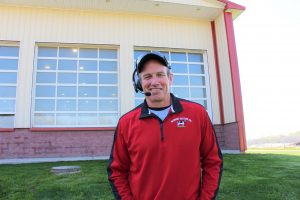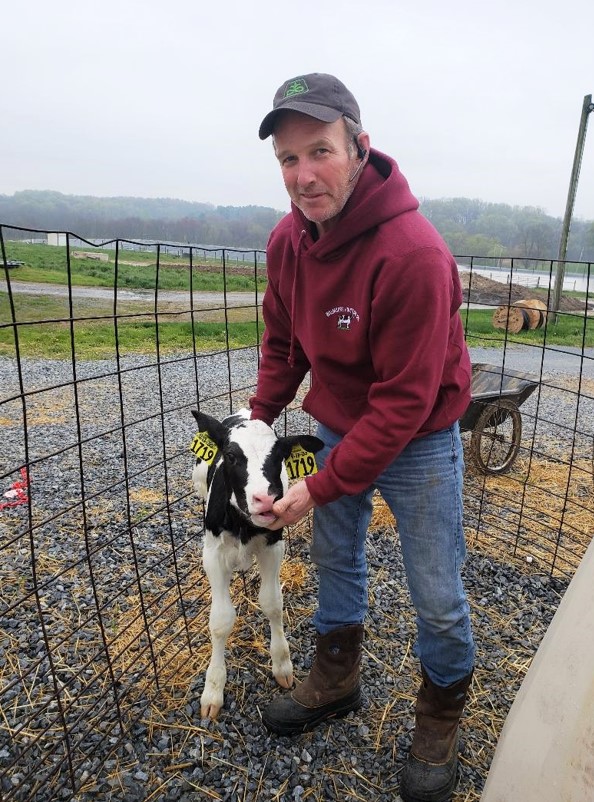
Walt Moore Was Featured in Ninth Episode of Cow-Side Conversations Podcast
With grain market prices reaching record highs this spring, Pennsylvania dairy producers are continuing to see feed costs that are well above historical averages. During the Center for Dairy Excellence’s ninth episode of the “Cow-Side Conversations” podcast, Walt Moore of Walmoore Holsteins in Chester County, Pennsylvania shared several strategies he uses to manage feed costs and overall efficiency on his operation. Moore is a fourth-generation dairy farmer and milks approximately 1,025 cows and farms about 1,800 acres.
Moore opened the podcast by describing his strategy for forage production. He grows a mix of conventional and BMR corn silage, triticale, and alfalfa haylage along with permanent grass that they use to make hay for dry cows and heifers. By closely monitoring seed selection and growing conditions, Moore strives for excellence with forage production, which he said has helped them manage feed prices in today’s market.
“We constantly try to make the best forages we can all the time. Of course we all know that can be a real challenge with weather and breakdowns but that’s one of our goals,” he said. “With protein prices being way up, we’re obviously glad to have pretty nice protein levels in our triticale and haylage to offset some of those costs.”
Getting maximized nutritional value out of his forages helps Moore keep feed costs in check throughout the year. He uses the Professional Dairy Managers of Pennsylvania (PDMP) and Penn State Extension corn silage trial to evaluate hybrids and make seed selections. He has served as a host farm for the trials for the last 10 years.
“It’s nice for me to be able to say, ‘This is what grows well in our soil and climate,’” he explained. “We know Pennsylvania geographically has quite a bit of variation in soil type and temperatures. I’ve been able to use those [trials] a lot for seed selection.”
For digestibility, Moore and his team look at non-digestible fiber and the rates of fiber digestion. Throughout the podcast, Moore provided certain percent ranges they use for dry matter based on the crop. With high protein costs, he also benchmarks regularly and monitors the MUN—milk urea nitrogen—in their milk.
“A great tool that we continue to use, and probably monitor more because of the high protein costs, are the MUNs in our milk. We get daily results of those,” Moore said. “If we see them creeping up a little bit, we take some protein out of the diet because we feel we’re overfeeding the cows. We’ll watch them and if we see a change, good. If not, we’ll take out a little more without sacrificing production.”
When it comes to harvesting, Moore and his team target certain moisture ranges to ensure a good pack and fermentation. They also monitor conditions and make real-time decisions about cut length. “If a crop gets dry and we’re worried about it, we’ll shorten the length of cut. With a few changes on the fly, you can often make up for some of those errors,” Moore said.
Sharing the positive relationships he has with his consultants is one of the highlights of Moore’s podcast. He described how he works with his nutritionist to monitor metabolic issues and set goals related to herd health. He also gains insight from seed salesmen and works with scouts during the growing season to analyze agronomic conditions and optimize his crops’ nutritional value.

Moore credits his nutritionist for helping him set and achieve high expectations. “I literally text daily with my nutritionist. I share our milk weight per cow for the total herd by shift and then by each individual group. That really keeps my nutritionist engaged. He knows what forages we’re feeding. He also has access to our MUNs and components. As we generate dry matter intake data, we also send him that,” Moore explained.
Throughout the podcast, Moore shared a few other strategies for managing feed costs:
- Forward price on grain when it makes sense. “I try to look forward when there are good buys, but I think it first starts with a conversation with the nutritionist. What have we fed traditionally? Do we want to keep doing that? The one downside to marketing way out is you’re kind of stuck with that feed, so you want to make sure it’s something that will fit in your diet long-term.”
- Monitor feed refusals. “On our lactating cows, we try to feed for a 3% feed refusal every day. We collect all those refusals, weigh them, and feed them to a low group of cows. We’re not wasting that feed, but it allows us to make sure we have feed in front of the cows all the time.”
- Feed specifically for milking groups, dry groups, and heifer groups. For his milking herd, Moore has five lactating diets with different groups that are based on stage of lactation. He has a different forage range for each group. For the dry cow herd, he runs two groups with completely different diets and forage ranges.
- Focus on small management practices. “I believe there are often a lot of little management practices – not just a silver bullet – that can be changed and tweaked over time to keep adding to that next pound of production or fix that health event you’re struggling with. The next thing you know, you’re saving a couple thousand dollars a month in feed costs and things can really turn around pretty quickly.”
With overall feed costs representing anywhere from 35 to 70 percent of the total costs on most dairy farms, Moore said finding effective management strategies can make a big difference in producers’ bottom line.
“To me, feed costs need a very high attention rate all the time from one end to the other. You have to be thinking ahead on it. I’m evaluating this year’s corn crop and already thinking about how we can improve management practices next year,” he added. “It basically makes or breaks you. The better the forages, the healthier the cows and the more productive they are. In a thin margin industry like we’re in, it can really make a huge difference on the bottom line.”
To listen to the full podcast interview, visit www.centerfordairyexcellence.org/podcast. The podcast is also available on Spotify, Apple Podcasts, and Amazon Music. With a new episode released each month, Moore’s interview is the ninth in the series. The podcast was designed to share real-time farmer insight, tricks of the trade, and inspiring stories from dairies across Pennsylvania.

